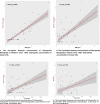Evaluation of chlorpyrifos residue in breast milk and its metabolite in urine of mothers and their infants feeding exclusively by breast milk in north of Iran
- PMID: 32030155
- PMCID: PMC6985376
- DOI: 10.1007/s40201-019-00398-3
Evaluation of chlorpyrifos residue in breast milk and its metabolite in urine of mothers and their infants feeding exclusively by breast milk in north of Iran
Abstract
Background: The most common method of combating insects in low-income communities and developing countries, is the use of insecticides. The use of organophosphate insecticides is increasing due to their low prices and availability on the market. Chlorpyrifos is a medium-risk insecticide for human. The widespread use of organophosphorus insecticides, especially chlorpyrifos, in residential homes has undoubtedly created many health concerns. Babies have a high sensitivity to pesticides and environmental contaminants because of their evolutionary status. On the other hand, the main source of infants' exposure who are breast-fed exclusively to environmental pollutants is through breast milk and oral contact with objects that are covered with dust and particles.
Methods: In this cross-sectional study, the concentration of chlorpyrifos in breast milk and its metabolite in urine samples of mothers and their under six months infants, feeding exclusively by breast milk in north of Iran have been investigated. The demographic data was collected through interviewing with selected mothers and completion of prepared data collecting forms. The data were statistically analyzed to investigate the relationships between exposure of mothers and their infants to chlorpyrifos.
Results: The mean concentration of chlorpyrifos and its metabolite in mothers' urine and milk samples and infant's urines were 1.3 ± 0.6, 2.1 ± 1.4 and 1.4 ± 0.7 μg/L, respectively. Also, the mean concentration of chlorpyrifos in the dust on the house floors was73.4 ± 49 ng/g. There are good correlations between the mean values of chlorpyrifos concentrations and its metabolite in mother's milk and urine (r = 0.872, p = 0.001), and the mother's milk and infant's urine (r = 0.722, p = 0.001). Also, there was a significant correlation between the concentration of chlorpyrifos in floor dust and its metabolites in the infant's urine (r = 0.554, p = 0.001).
Conclusion: Our study suggests that the infants are the recipient of concentrated forms of chlorpyrifos residues through breast milk and house dust and it is quite well known that OP pesticides are toxic and have different kinds of adverse health effects. However, further research needs to be done to determine what these chemicals are doing to our children.
Keywords: Breast milk; Chlorpyrifos; Household insecticide; Iran; Urine.
© Springer Nature Switzerland AG 2019.
Conflict of interest statement
Conflict of interestThe authors declare that there is no conflict of interest.
Figures




References
-
- Dehghani R, Moosavi SG, Esalmi H, Mohammadi M, Jalali Z, Zamini N. Surveying of pesticides commonly on the markets of Iran in 2009. J Environ Prot. 2011;2:1113–1117. doi: 10.4236/jep.2011.28129. - DOI
-
- Vanden Bilcke C. The Stockholm convention on persistent organic pollutants. RECIEL. 2002;11(3):328–342.
LinkOut - more resources
Full Text Sources
Miscellaneous

